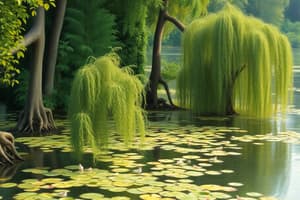Podcast
Questions and Answers
Which of the following is NOT a component of the natural environment?
Which of the following is NOT a component of the natural environment?
- Climate
- Socioeconomic activities (correct)
- Geography
- Fauna
Objects manufactured by humans are considered a component of the natural environment.
Objects manufactured by humans are considered a component of the natural environment.
False (B)
Name two components of the cultural environment.
Name two components of the cultural environment.
Objects manufactured by humans and socioeconomic activities.
The destruction of habitat can lead to the displacement of animal and human ______.
The destruction of habitat can lead to the displacement of animal and human ______.
Which of the following is NOT a main consequence of human activities on the environment?
Which of the following is NOT a main consequence of human activities on the environment?
Match the following:
Match the following:
Which two components does ecology study?
Which two components does ecology study?
An ecosystem only includes living organisms and not their physical surroundings.
An ecosystem only includes living organisms and not their physical surroundings.
Define an ecosystem.
Define an ecosystem.
An ecosystem is the sum of biotopes, relationships and ______.
An ecosystem is the sum of biotopes, relationships and ______.
Which is one of the two components of the ecosystem?
Which is one of the two components of the ecosystem?
Biocenosis refers to the physical and chemical conditions of an environment.
Biocenosis refers to the physical and chemical conditions of an environment.
What are the two components of a biotope?
What are the two components of a biotope?
The physical medium of the ecosystem and its environmental conditions are components of the ______.
The physical medium of the ecosystem and its environmental conditions are components of the ______.
What is exchanged in the physical medium of the biotope?
What is exchanged in the physical medium of the biotope?
Aquatic and terrestrial are the two types of physical medium.
Aquatic and terrestrial are the two types of physical medium.
What are abiotic factors?
What are abiotic factors?
Chemical and physical factors that determine the environmental conditions of the biotope are known as ______ factors.
Chemical and physical factors that determine the environmental conditions of the biotope are known as ______ factors.
Which of the following is not an abiotic factor?
Which of the following is not an abiotic factor?
The presence of light allows organisms to exist as photosynthetic organisms.
The presence of light allows organisms to exist as photosynthetic organisms.
Flashcards
Natural Environment Components
Natural Environment Components
The natural environment's components include climate, geography, fauna, and flora.
Cultural Environment Components
Cultural Environment Components
The cultural environment includes objects made by humans and their socioeconomic activities.
Consequences of Human Activities
Consequences of Human Activities
Human activities cause species extinction, water contamination, and displacement of animal and human populations through habitat destruction.
Ecology Focus
Ecology Focus
Signup and view all the flashcards
Define Ecosystem
Define Ecosystem
Signup and view all the flashcards
Ecosystem Components
Ecosystem Components
Signup and view all the flashcards
Biotope Components
Biotope Components
Signup and view all the flashcards
Physical Medium of Biotope
Physical Medium of Biotope
Signup and view all the flashcards
Abiotic Factors
Abiotic Factors
Signup and view all the flashcards
Five Abiotic Factors
Five Abiotic Factors
Signup and view all the flashcards
Light in Ecosystems
Light in Ecosystems
Signup and view all the flashcards
Water's Role
Water's Role
Signup and view all the flashcards
Temperature's Impact
Temperature's Impact
Signup and view all the flashcards
Wind Action
Wind Action
Signup and view all the flashcards
Atmospheric Pressure
Atmospheric Pressure
Signup and view all the flashcards
Study Notes
- The following study notes cover a range of topics related to the environment and ecosystems, including their components, human impact, and ecological studies
Medio Ambiente (Environment)
- The environment encompasses both natural and cultural components
- Natural components are:
- Climate
- Geography
- Fauna
- Flora
- Cultural components are:
- Objects made by humans
- Socioeconomic activities
Actividades Humanas y el Ambiente (Human Activities and the Environment)
- Consequences of human activities on the environment include:
- Extinction of species
- Water contamination
- Displacement of animal and human populations due to habitat destruction
Ecología (Ecology)
- Ecology studies the relationship between living beings and the environment
Ecosistema (Ecosystem)
- An ecosystem is defined as the physical environment where living beings live and the relationships they establish among themselves and with their environment
- It comprises a set of living beings that inhabit a part of the biosphere
Componentes del Ecosistema (Ecosystem Components)
- The two main components of an ecosystem are:
- Biotopo
- Biocenosis
Biotopo
- The biotopo's components are:
- Physical environment of the ecosystem
- Environmental conditions of the ecosystem
- The term "topo" in biotopo relates to topography
Cuadro Sinóptico del Ecosistema (Ecosystem Synoptic Chart)
- In the synoptic chart, an ecosystem represents the sum of its components and their relationships
Medio Físico del Biotopo (Physical Environment of the Biotope)
- The physical environment of the biotope is where the living beings of an ecosystem reside
- Matter and energy are exchanged in this environment
- The two types of physical environments are:
- Aquatic
- Terrestrial
Condiciones Ambientales del Biotopo (Environmental Conditions of the Biotope)
- The environmental conditions of a biotope involve function
- Abiotic factors, which are chemical and physical factors, determine the environmental conditions of the biotope
Factores Abióticos (Abiotic Factors)
- Abiotic factors, with their respective functions within an ecosystem, include:
- Light: the main source of energy for ecosystems, allowing photosynthetic organisms to exist
- Water: involved in the water cycle
- Temperature: determines which species inhabit an ecosystem
- Wind: air in movement
- Atmospheric pressure: The force exerted by the weight of air in an area
Studying That Suits You
Use AI to generate personalized quizzes and flashcards to suit your learning preferences.




